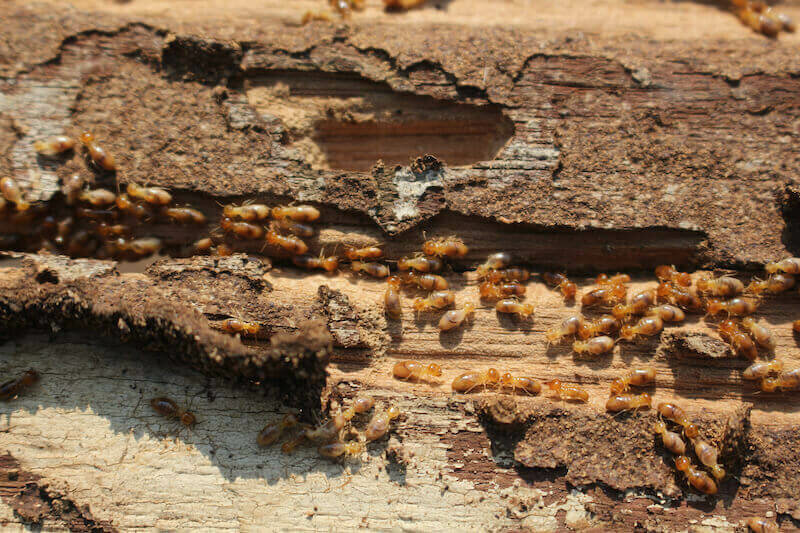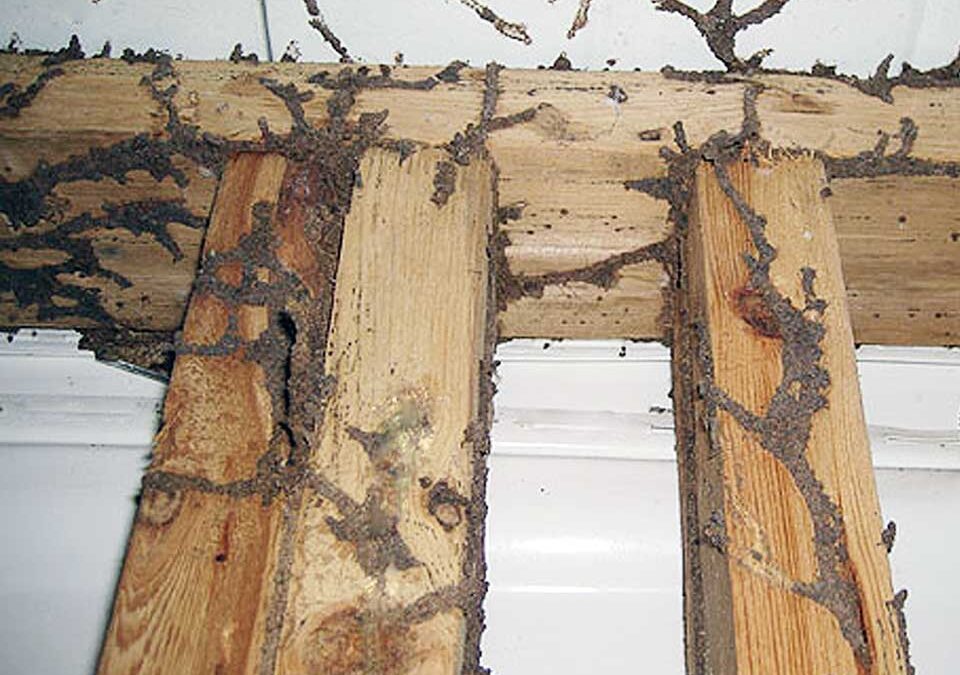Termite Treatments in Florida
Exterminator Services for Tampa, Lutz, Land O Lakes, Brandon, Wesley Chapel, Zephyrhills, Valrico, Riverview
Termites often pose a serious threat to homes and businesses in Florida. They feed on wooden parts of a building, usually hiding from view while quietly weakening crucial supports. In places such as Tampa, Lutz, Land O Lakes, Brandon, Wesley Chapel, Zephyrhills, Valrico, or Riverview, termites can remain active for much of the year, thanks to the region’s mild to warm climate. Learning how termites spread, knowing the first signs of an infestation, and getting professional termite treatments in Florida from a qualified exterminator all help prevent extensive repairs or health concerns. Below, you will learn the main reasons termites flourish in Florida, clues pointing to an infestation, and why a strong, ongoing plan is needed to remove and deter them. You will also find suggestions on keeping new colonies from taking hold once your current termite issue is resolved.
Why Termites Keep Growing in Florida
- Warm Temperatures
Florida avoids the winter cold that might curb termite numbers in some northern states. Termites can consume wood and breed for most months here, steadily expanding their colonies. - Consistent Moisture
Many termite species need moisture to build protective tunnels or keep their nests humid. Florida’s high humidity, along with soil that stays damp, gives subterranean termites excellent survival conditions. - Ample Wooden Structures
Termites feed on cellulose, so any wooden beams, fences, or framing that directly contacts the ground may become a target. If these items are left untreated or damp, the risk of infestation grows. - Arrival Through Goods
Some drywood termites travel on furniture or wooden objects brought in from elsewhere. If overlooked, a few unnoticed termites can settle and quietly multiply in hidden beams or rafters.
Understanding Florida’s Ant Population

Signs of a Termite Infestation
- Mud Tubes
Subterranean termites create small soil based tubes on foundations or walls to keep their tunnels moist and shielded from light. Pencil thick tubes often appear branching up from the ground. - Discarded Wings
Termite swarmers, which are winged reproductives, emerge to mate and form new colonies. Once they settle, they drop their wings, leaving small piles of clear or translucent wings on windowsills or near doors. - Frass Droppings
Drywood termites produce small pellet shaped droppings that might resemble sand or sawdust. Spotting small heaps of these near a wall base or windowsill signals a possible hidden colony. - Hollow Wood
Termites eat wood from the inside outward, leaving a thin surface layer intact. Tapping beams, floors, or window frames that sound hollow often means termite damage within. - Bubbling or Distorted Paint
If termites tunnel near the surface, paint or wallpaper may appear bubbled or uneven. Some owners mistake this for water damage until closer inspection reveals termite activity.
Why a Fast Response Is Important
- Structural Weakness
Termites can undermine integral beams, risking the overall stability of a property. Overlooking a growing nest leads to expensive repairs or replacements. - Higher Costs Over Time
Damage accumulates quickly once termites spread to multiple areas. Act promptly to avoid bigger reconstruction bills. - Potential Health Concerns
While termites are not known for spreading disease, the stress of living with hidden pests is significant. Damaged wood or leaky zones may also encourage mold or other issues. - Business Disruption
In commercial properties, termite activity might force partial closures for repairs or harm customer confidence if discovered. Early detection spares these hassles.
Why You Need a Termite Exterminator
Home remedies, sprays, or partial attempts rarely kill every termite if large sections of wood or deep soil nests remain untouched. Subterranean termites often reside in soil outside your building, while drywood termites hide in attics or furniture cracks. A termite exterminator knows how to identify the termite species, select the right solutions (for instance, applying barrier treatments or using fumigation for drywood types), and ensure eggs or hidden colonies are also removed. They also guide owners on drying moisture prone spots or limiting wood to ground contact, discouraging a new wave of termites.

Our Termite Treatments in Florida
- Full Inspection
We check exterior foundations, crawl spaces, or fences for mud tubes or direct wood to soil contact. Indoors, we examine attics, baseboards, or stored wooden objects for droppings, wing piles, or hollow sounding beams. - Customized Steps
We might trench the foundation soil and apply termiticide barriers if subterranean termites appear. Bait stations can also be installed to lure worker termites, allowing the poison to spread through the colony. If drywood termites occupy multiple beams, fumigation may be advised. Spot treatments may suffice for smaller zones. - Occupant Safety
Some tasks, like fumigation, require residents to leave for a short time. Soil treatments or baits generally let people stay home. We explain each step in detail so everyone is comfortable and informed. - Follow Up and Prevention
Termites return if damp conditions or wood contact are not fixed. We recommend checks every year or two, occupant habits like clearing wood scraps away from walls, and ensuring no leaks remain in attics or basements.
Termite Problems in Tampa
Tampa’s busy commerce, mild weather, and blend of older and newer buildings all provide opportunities for both subterranean and drywood termites to settle. Wood fences or decks in direct soil contact, along with occasional moisture from Florida rains, lure in termites hunting for new feeding sites. Our termite exterminator approach in Tampa typically begins with thorough property checks, from looking at foundation soil to inspecting attics for droppings. After removing active termites using barrier treatments or spot fixes, occupant routines like trimming bushes that touch walls or storing firewood off the ground help protect against new arrivals.
Neighboring Towns: Lutz, Land O Lakes, Brandon, Wesley Chapel, Zephyrhills, Valrico, Riverview
In these surrounding communities, Florida’s climate remains equally inviting for termites. Homeowners might spot mud tubes along fences or suspicious pellets near windows, pointing to either subterranean or drywood colonies. Our termite treatments in Florida address the specific species, from setting up bait stations outside to local injections of wood in accessible areas. If the colony is widespread, tenting may be used. After elimination, owners are counseled on removing rotted stumps, sealing wood cracks, and reducing moisture near the foundation. This balanced plan prevents a quick termite reentry and secures the investment in repairs or upgrades.

Protecting Against New Termite Infestations
- Limit Wood to Ground Contact
Fences, deck posts, or wooden trims that rest against soil are at higher risk. Lifting or placing a gap between soil and wood denies termites an easy route. - Keep Areas Dry
Check pipes and drains to ensure water is not gathering near beams or basements. Fix leaks and maintain good ventilation for crawl spaces or attics. - Annual or Biannual Inspections
Catching termites early keeps structural fixes small. A professional check each year or two ensures no mud tubes or droppings go unnoticed. - Use Treated Wood
For outdoor projects, pick pressure treated lumber or other resistant materials. Treat or seal wooden items if they might face frequent moisture. - Remove Debris
Stacks of scrap wood, old stumps, or rotting logs near the property encourage termites to start a nest outside, then move indoors.
Contact Us for Strong Termite Removal
If you see mud tubes, discarded wings on windowsills, or find hollow sounding beams, it is wise to act quickly. Contact us to learn more or schedule your service. Our termite treatments in Florida integrate thorough inspections, specific solutions like soil termiticide barriers or fumigation, and occupant steps to cut off future activity. Whether you live in Tampa, Lutz, Land O Lakes, Brandon, Wesley Chapel, Zephyrhills, Valrico, or Riverview, each plan is personalized to your building’s layout and termite type. By eliminating adult colonies, dealing with moisture spots, and sealing wood to ground contact, we secure your property and help you avoid major repair costs.
Keeping Your Property Termite Free
Although Florida’s climate promotes termite growth, diligent checks and professional termite exterminator methods prevent them from destroying expensive wood elements. Early signs like wing piles or mud tubes let you schedule fast treatments, minimizing damage. Maintaining dryness, using treated lumber, and storing items away from the ground all reduce termite interest over the long run. Residents of the Tampa area or outlying communities who catch infestations early, trust professional solutions, and follow occupant guidelines can look forward to a sturdier property with fewer pest worries.
